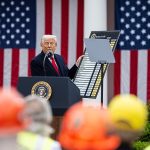President Ronald Reagan took bold action in 1987 to protect American jobs from unfair trade practices. He slapped a 100% tariff on Japanese electronics like TVs and computers. This move sent a clear message: America wouldn’t let other countries cheat our workers.
Reagan hated tariffs. He believed in free trade. But Japan broke a deal to stop dumping cheap microchips worldwide. The U.S. semiconductor industry was at risk. Reagan had no choice but to fight back. He wanted fair play, not handouts.
The tariffs worked. Japanese companies started playing by the rules. Reagan’s team said the tariffs were a last resort. They were careful to pick products that wouldn’t hurt everyday Americans. Prices stayed stable because other countries filled the gap.
Harley-Davidson motorcycles got a similar boost earlier under Reagan. He put tariffs on foreign bikes to save the company. Harley bounced back, saved thousands of jobs, and became an American icon. Reagan showed tariffs could work when used wisely.
The Japan tariffs didn’t last forever. Reagan lifted half by late 1987 after Japan opened its markets. The rest stayed until he left office. His successor, George H.W. Bush, finished the job. By 1992, foreign chips had 20% of Japan’s market—exactly what Reagan wanted.
Critics warned of trade wars. Reagan knew the risks. In speeches, he said tariffs usually backfire. But sometimes you must stand strong. His tough love with Japan worked without starting a global crisis. It was a lesson in balancing ideals with real-world problems.
Today’s leaders could learn from Reagan. He put America first without burning bridges. The tariffs were targeted, temporary, and tied to clear goals. They saved industries and jobs while keeping trade flowing. That’s the Reagan way—smart, strong, and practical.
Reagan proved conservatism means defending workers and free markets. He didn’t let ideology blind him to shady deals. When others cheated, he acted—but always with a plan. That’s leadership: protecting what matters without losing your principles.




